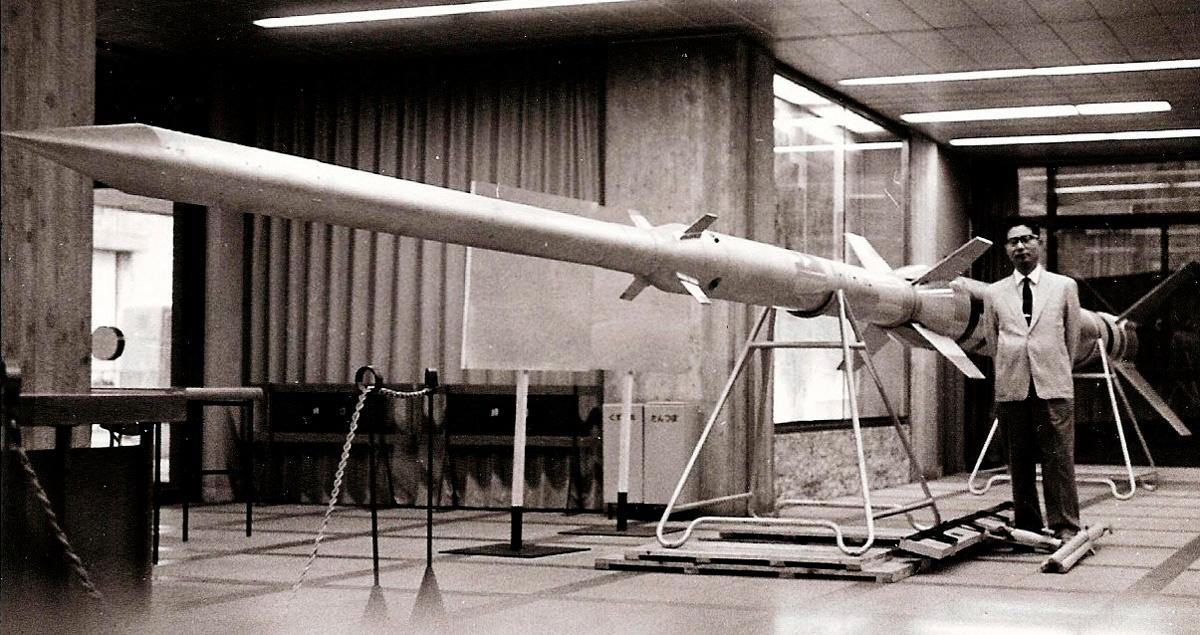Dr. Rocket builds a lab

Index
After successfully testing his “Pencil Rocket” in 1955, Dr. Rocket, as Hideo Itokawa came to be known, continued to develop the Pencil as a platform for learning more about rocketry. At the Itokawa Laboratory on the Chiba campus of the Institute of Industrial Science, Itokawa and colleagues tested later versions of the Pencil including one measuring 300 millimeters (11.8 inches) long and another with two stages including a booster. Grappling with unreliable electronics and many failures, the team was nonetheless getting flights of 10 to 20 meters (33 to 66 feet) and gradually accumulating knowledge and experience. The Pencil was eventually replaced by larger, more powerful models, including the Baby rocket and the Kappa rocket, which soared ever higher above the Earth.
The two-stage K-6 Kappa rocket, for instance, was 5.4 meters (17.7 feet) long, weighing 255 kilograms (562 lbs.), and reached an altitude of 60 kilometers (37 miles) in 1958. (Itokawa’s team was also able to contribute to the IGY program that year by reporting wind and temperature readings in the upper atmosphere.) Two years later, the K-8 version hit 200 kilometers (124 miles). These tests were also scientific experiments: a K-8 was the first rocket to measure the ionic density of cosmic rays, according to Japan’s space agency, JAXA.
1964 was a banner year for Itokawa and Japanese rocket science. A Lambda rocket managed to fly to an altitude of 1,000 kilometers (621.3 miles) and the Institute of Space and Aeronautical Science (ISAS) was established. Six years later, Japan became the fourth country in the world to put a satellite into orbit with the launch of the Osumi, an experimental satellite developed under Itokawa. “Itokawa was of course the pillar of the project,” recalled Yasunori Matogawa, a professor emeritus at JAXA who studied engineering under Dr. Rocket for two years in the mid-1960s. “Though he was too busy to teach his students, and was very busy in negotiating with politicians and bureaucrats regarding many problems in pushing the Japanese space project forward as a really powerful man of originality, he was highly respected by all members in the institute.”

Immortalized in Space
After he retired from ISAS in 1967, Itokawa set up a company to commercialize systems engineering technology based on aerospace research. A true Renaissance man, Itokawa also used his retirement to take up ballet lessons. After five years of study, he appeared in Prokofiev’s Romeo and Juliet at the Imperial Theater in Tokyo, leaving audiences agog at the sight of the aged professor performing with dancers who were much younger.
When Itokawa died in 1999, he left a legacy that’s difficult to overstate. The institute he founded, ISAS, became one of the building blocks of JAXA, which was launched in 2003. Two years later, JAXA’s Hayabusa unmanned space probe completed a journey of about 2 billion kilometers (1.24 billion miles) and arrived at an asteroid named in honor of Dr. Rocket himself. In a world’s first, Hayabusa retrieved samples from 25143 Itokawa and later returned them to Earth for analysis.
The epic journey to the asteroid and back recalls a haiku poem written long ago by Itokawa. It evokes Dr. Rocket’s undying spirit of exploration, a source of inspiration for generations of explorers, engineers and dreamers: “The sky is high and my imagination is far away over the autumn sea.”





